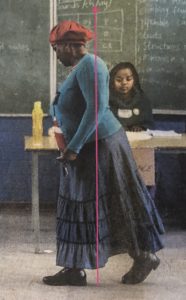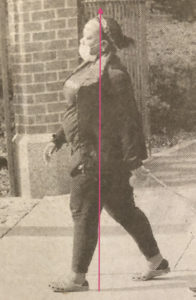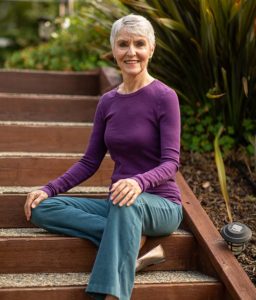

Okay, here’s an education for you.
Take a guess, which of the women in the image above has better posture?
If you live in an industrial culture, like the US, my bet is that you would vote for the woman on the right. After all, she’s looking forward and her head is well back over her shoulders.
Sorry, no, the posture prize goes to the woman on the left.
The images above are similar but oh so different.
Let’s take a moment to define what makes one posture better than another.
The best posture creates the least amount of wear and tear. There’s no undue pressure anywhere in the body. In the best posture, the bones and joints align in their optimal, natural positions. When the pelvis comes into its optimal, natural position, the entire skeleton aligns with gravity.
Look again. Which woman looks more comfortable in her body? Which one can walk further without pain? Which one has stress in her knees.? Which one has a swayback? Which one has a tense back?
I have added lines at approximately the center of their bodies. The spine of the woman on the left parallels the line. It is close to being a column of bones.
The woman on the right holds her head so far back, that it can’t rest on a column of bones. The only way her head can be this far back is if she has a swayback lower in her spine. Her back is misaligned and tense and nothing will give her permanent relief until she centers her pelvis and aligns her spine.
How do we know this?
Balance (Aplomb) grew out of close observation of people around the world who remain strong, mobile, and energetic well into their old age. No matter where or when they lived, these people all shared the same characteristics of alignment. So do healthy young children the world over.
When I started to study with Angie Thusius, the person who brought Aplomb to the US, I understood quickly that she could see things about skeletal alignment that I was blind to. She would get excited by certain images while I was clueless about what the big deal was. As someone who grew up immersed in a culture in which Balance is the exception, I had to learn the characteristics of optimal posture.
Balance is an education.
There are three components to learning Balance: 1) to be able to see the difference between a person who has retained their original alignment and one who has lost it; 2) to learn the guidelines to know what to do to reclaim your Balance; 3) to practice in your daily life.
Even though today’s emphasis is on being able to “see” Balance it is my experience that all three components of learning this work go together.
I needed the help of the guidelines to see if a person was in original alignment. To this day, being able to tell if a person is in or out of Balance motivates me to practice.
When I see a person who is particularly Balanced I am eager to “be like them.” When I see someone whose alignment causes them to suffer I am more motivated to check my own positioning. Seeing helps me practice.
This Friday’s noon class on Zoom – number 87 (my how time flies!) – we will discuss more “seeing.” Our goal is to “Hit Our Stride.” To that end, we will mobilize our ankles and knees and then practice grounded walking. Join me.
~Jean Couch



4 Responses
Can I join your Friday class? I came once before.
Louise, we’d love to have you once we begin classes again on September 9th. Jean’s taking the rest of the Summer off from Friday classes. Feel free to book a private with her if you’d like to see her before then for a 1 on 1 training: https://balancecenter.com/services/#1-1-session.
I enjoyed this article, Jean. And looked at Angie Thusius on YouTube.
You just keep inspiring me to practice practice practice. it’s so fun!
Fun is the word, Karen. And then the benefits multiply.
Love,
Jean